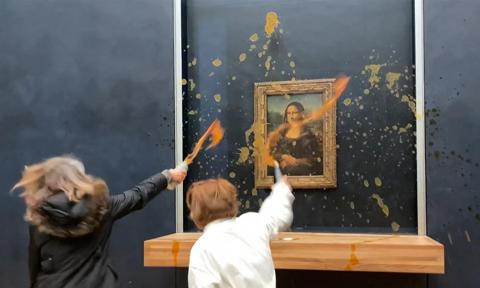
The Mona Lisa was attacked recently when protestors threw pumpkin soup at it to send their message across. This is the latest stunt in the long line of attacks by protesting groups to highlight their causes.
On Sunday, protestors from the Riposte Alimentaire (Food Counterattack) group splattered the painting with pumpkin soup at The Louvre while addressing the onlookers. The group claimed that this was a call for the right to “healthy and sustainable food” and was done to highlight the ongoing farmer protests across France.
Climate activists throw soup on the Mona Lisa painting at the Louvre museum. pic.twitter.com/SOh4kvsWPK
— Academia Aesthetics (@AcademiaAesthe1) January 28, 2024
Farmers have been using tractors for days to set up road blockades and slow traffic across France to seek better reumeration for their produce, protection against cheap imports, and reduction of red tape.
The pumpkin soup did not touch the painting and Mona Lisa remains unharmed, thanks to its bulletproof glass casing.

While many showed their support for the vandals and their protesting technique, there were many who condemned it and called it a futile stunt. France’s Minister for Culture Rachida Dati took to X, formerly Twitter, to speak against the attack, writing that “no cause” could justify the Mona Lisa being targetted.
Has the Mona Lisa been attacked before?
Being one of the world’s most famous artworks has made the Mona Lisa a regular target for vandals and protestors. This is not the first time the painting by Leonardo da Vinci was vandalised.
In 1956, a vandal pured acid on the masterpiece and in 1974, it was sprayed with red paint while on display at the Tokyo National Museum. In 2019, a visitor threw a teacup at the painting. In 2022, a climate change activist, who did not claim to be associated with any formal group, pulled a similar stunt back in May when he threw cake on Mona Lisa after failing to smash the glass that protected the iconic artwork.
Why do protestors attack famous artwork?
Climate change awareness activists have tried many tactics to bring attention to the threat that looms dangerously close to our planet, whether it’s by gatecrashing runways at fashion week or streaking through red carpets. More recently, these activists have taken to vandalising priceless pieces of art in the name of protesting inaction against climate change.
If you recall, members of the environmental activist group Just Stop Oil recently threw cans of soup on Van Gogh’s Sunflowers which is on display at the National Gallery in London. The 20-year-old protestors then proceeded to glue themselves to the wall near the painting and shout, “What is worth more, art or life? Is it worth more than food? More than justice? Are you more concerned about the protection of a painting or the protection of our planet and people?”
Activists with @JustStop_Oil have thrown tomato soup on Van Gogh’s Sunflowers at the national Gallery and glued themselves to the wall. pic.twitter.com/M8YP1LPTOU
— Damien Gayle (@damiengayle) October 14, 2022
A few days after the incident, members of another activist group, Last Generation, threw mashed potatoes at a Monet in Germany to highlight their cause. “People are starving. People are freezing. People are dying,” said one of the protesters, after glueing their hands to the wall beneath the artwork, “We are in a climate catastrophe, and all you are afraid of is tomato soup or mashed potatoes on a painting. You know what I’m afraid of? I’m afraid because science tells us that we won’t be able to feed our families in 2050.”
We make this #Monet the stage and the public the audience.
— Letzte Generation (@AufstandLastGen) October 23, 2022
If it takes a painting – with #MashedPotatoes or #TomatoSoup thrown at it – to make society remember that the fossil fuel course is killing us all:
Then we'll give you #MashedPotatoes on a painting! pic.twitter.com/HBeZL69QTZ
While many might not necessarily put it in the same category as these other priceless pieces of art, Prince Charles’ wax figure at London’s Madame Tussauds got smeared with custard pies by protestors from the Just Stop Oil group more recently.
BREAKING: Just Stop Oil activists have thrown custard pies into the face of King Charles's waxwork at London's Madame Tussauds. More follows... pic.twitter.com/xqE7NkZhH6
— TalkTV (@TalkTV) October 24, 2022
While all the protesters were later taken into custody by the police, they did manage to succeed in their goal, which was to bring attention to the protests, however divisive the attention might be. There are some who are applauding these young activists for putting themselves out there for a good cause, while there are others who have been criticising these misguided attempts to bring about any concrete change.
Is destroying a historic piece of art, mostly by artists who revered nature and portrayed it beautifully through their works, a sensible way to counteract complacency in the face of the climate crisis? These protest groups certainly think so.
It is also worth noting that none of the artworks mentioned above were actually destroyed in these protests. Just Stop Oil claimed that they took into account the fact that Van Gogh’s painting was protected by the glass before throwing the cans of soup on it. The mashed potatoes-laden Monet is also unharmed and would go on display again in a few days.
If nothing, then these climate change activists have managed to stir up a conversation around the subject but, historically, this course of action doesn’t necessarily result in change. Online debates and conversations already run the risk of getting derailed and are often put on blast without solid arguments providing context.
Is it a misguided attempt that will only serve to derail the progress made by on-ground climate activists or is this the need of the hour? What do you think?
- Quick links
- Climate Change
- Art
- Mona Lisa






